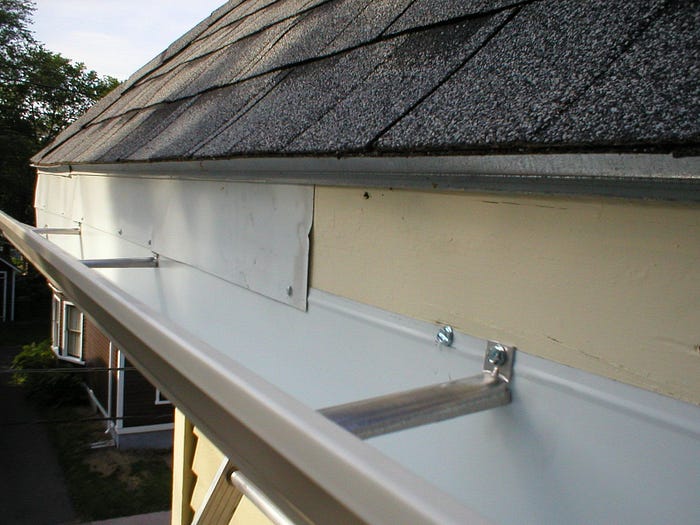Introduction
The structural integrity of your house roof mainly depends on keeping it safe from water or moisture. One simple way is to install a drip edge on the roof. Your roof may or may not have it when you bought your house but most building codes require you to have it.

You can either install it on your own or hire a reliable and experienced roofer in your area to install it around the edges of your roof. With a few tools, manual dexterity, and attention to detail, you can install a roof drip edge. Drip edge basically overhangs the sides of the roof and has a small flange bent away from the fascia board. It is structurally stable as the metal is non-staining and non-corrosive.
Here are some of the frequently asked questions with the best possible answers for you. Whether you are a DIY enthusiast or prefer hiring a team of experts, this information can be super helpful for you.
What Is Drip Edge Flashing?
Drip edge is an angled piece of angled flashing that is typically installed over the fascia board. Drip edge flashing is installed on the rake, gable, or eaves of your roof, depending on its shape. They generally extend beyond the fascia and should be kept at a minimum of one-third of the gutter width.
The flashing is made up of non-corrosive, non-porous, and non-staining metal. Copper, aluminum, and galvanized steel are the most commonly used metals but you can also find drip edges made up of vinyl, fiberglass, or any other durable plastic.
There are two basic profiles for drip edge flashing you must know about.
Type C
Generally known as C style or gutter apron, this extended drip edge has a longer leading edge. It is directly applied to the sheathing and beneath the roof underlayment. Gutter aprons come in the form of L and any water that infiltrates the roof is directed towards the roof gutters. It is bent to a 90-degree angle and has a lower flange at the bottom of the edge.
Type D
The most common profile of drip edge is type D and it is shaped like a T. It goes over the roof deck, under the shingles, and directly to the rake boards behind the roof gutters. The design is made to direct water away from the fascia.
What Is Drip Edge Used For In Roofing?
The primary purpose of the drip edge is to direct water away from the fascia and prevent it from rotting. During rainy seasons, it protects the edge of the decking due to water penetration.
Secondly, it seals any gaps at the bottom of the roof that can allow small animals to infest your attic. During the snowy season or winter months, it protects the bottom of the roofline from the damages caused by ice dams.
A drip edge also plays an important role in preventing any movement between deck boards and fascia, maintaining the structural integrity of your roof. By assisting the roof gutter, drip edges improve the longevity and overall effectiveness of your house roof. As the drip edge material is non-corrosive, you can expect to enjoy peace of mind for years to come.
Know that if installed incorrectly, drip edge can double up the risk of water retention for your roof. Read along to know the right way to install it.
Complete Guide to Drip Edges for Various Roofs
Each home is unique and so is its roof design. When it comes to protecting it from water seepage, you have to install the right kind of drip edge using the right techniques. We have compiled brief guides for installation on different roof types.
How To Bend Drip Edge?
When it comes to drip edge installation, the biggest challenge is to bend it around the corners. Luckily you can avoid those nasty poky points by using the right protocols. The first step is to accurately measure the width of the drip cap.
Mark the corner of your bend with a dark-colored marker. Draw line A at the corner of your bend. Now double up the width of the cap. Mark a line B keeping double the width of the cap distance between the two lines. Then mark a line C exactly between the two lines. Now create a triangle between lines C and B and cut at these two lines.
Use a knife to cut the section of metal between C and B. Now cut along the edge between lines A and B and bend this metal section 90 degrees back. Then cut the triangle leaving a wee bit of the width.
Simply put the bent side over the corner and fold the flashing to create a perfect corner.
How To Install Drip Edge On Metal Roof?
Although installing a drip edge over a metal roof is not necessary, especially when the overhang is greater than one inch, you can install it for improved safety. If you are planned to install a drip edge on a metal roof, follow these simple steps to get done with the job.
· Make sure you are purchasing a drip edge that is 36 gauges. Aluminum is the most commonly used drip edge metal for securing metal roofs. Measure the edges and purchase accordingly.
· Have all of your installation tools and materials ready. Make sure the roof is free of debris and the weather is dry.
· In order to work properly, the lower rim of the roof must be ¾ inches. Wear your safety gear and request help from your friends and family members.
· Once you are standing at a safe height, insert the wide plank of the cap all the way underneath the metal roofing. The outer edge must extend past the roof gutter.
· Now secure it in the place using nails and seal the flashing to the roof by dripping roof cement. Keep pressing down while adding roof cement. Add it on the edges and cut corners to achieve flawless roof edges.
How To Install Drip Edge On Shed Roof?
When you build a shed in your house, it should be protected from water woes. You can make it waterproof by installing a drip edge around the perimeter of the shed. It’s a straightforward process if you have got the right tools and metal flashing. The first step is to install an eave drip edge by nailing it to the roof sheathing. Now extend the edges one inch at each end. Install roofing felt over it and then rake drip edge. Its recommended to nailing every 12 inches or less for the best protection. Make sure that edges overlap. Bend corners and secure them under the rake edge to keep water from penetrating the roof corners.
How To Replace Fascia Board With Drip Edge On Existing Roof?
There comes a time when you have a replace fascia board with drip edge on the existing roof. It is a bit challenging but definitely possible. It involves pulling nails and cutting replacement materials. Start by accurately measuring and cutting fascia boards.
Now mount the ladder and pry up the metal spikes securing the roof gutter. Lower the gutter carefully and place it in a safe place for reinstallation. Use a nail puller to pry up the nails installed at the bottom flange. Once you have removed the bottom flange from the fascia board, pull the top flange out from the under the roof shingles and put it aside. Then pry off the fascia boards and discard them.
Nail the pressure-treated lumber onto place using high-quality nails. Fasten the fascia well to soffits and rafters. Now install the roof gutters and nail metal spikes into their place. Insert the drip edge beneath the shingles and secure it at the place with roofing cement.
How To Replace Fascia Board With Drip Edge On Barrel Tile Roof?
The fascia board is the protective cover for the timber joints beneath the barrel tile roof but it can rot. You can replace the fascia boards by taking accurate measurements as the first step. Prefer pressure-treated lumber to get a fascia that lasts long. Remove the gutters and pry up the drip edges safely from the existing fascia board. Once you have access to the boards, carefully remove them and clear off any debris. Secure new fascia board with non-corrosive nails to the rafters. Then add gutters and install the drip edge again.
How To Replace Fascia Board With Drip Edge On Flat Roof?
Fascia boards are at risk of rotting, especially when installed on flat roofs. Luckily the method to replace them is exactly similar to the one used for the existing shingle roof.
What Should Be The Gap Between Drip Edge And Fascia?
The gap between the drip edge and fascia can make or break the game for you. The best installation method is to leave a gap of 2.5 cm or the width of a finger between the fascia board and the drip edge. According to roofing experts, shingles should also overhang the drip edge 3⁄8 to 1/2 an inch.
